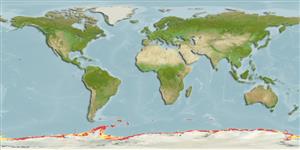| Native range | All suitable habitat | Point map | Year 2100 |

|
| This map was computer-generated and has not yet been reviewed. |
| Trematomus hansoni AquaMaps Data sources: GBIF OBIS |
Issue
This species is placed in the genus Pseudotrematomus in Eschmeyer (CofF ver. Sep. 2011: Ref. 88002).
Human uses
Phylogenetic diversity index
(Ref. 82805)
PD50 = 0.5005 many relatives (e.g. carps) 0.5 - 2.0 few relatives (e.g. lungfishes)
Trophic Level
(Ref. 69278)
3.4 ±0.54 se; Based on food items.
Resilience
(Ref. 69278)
Medium, minimum population doubling time 1.4 - 4.4 years (K=0.22-0.23; Fec = 5,851-12,000)